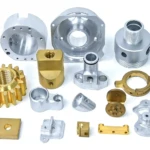Introduction to 3D Printing in the Aerospace Industry
The aerospace industry has long been at the forefront of technological innovation, and the integration of 3D printing has been a significant milestone in this quest. Since the first 3D printers were sent to space in 2014, this technology has evolved to play a crucial role in the design, manufacturing, and operation of spacecraft and satellites. In this blog post, we will delve into the applications, benefits, and future prospects of 3D printing in the aerospace industry.
Optimization of Rocket Parts
One of the primary advantages of 3D printing in aerospace is the optimization of rocket parts. By using advanced design techniques such as topological optimization, complex geometries can be created that are both robust and lightweight. This is particularly important in space exploration, where every gram counts, and the weight of a rocket or satellite directly affects its launch cost and efficiency. For instance, the cooling channels for a rocket engine can be integrated directly into the combustion chamber using 3D printing, which would be difficult or impossible to achieve with traditional machining or injection molding.
Use of New Materials to Improve Performance
3D printing has also enabled the use of advanced materials in the aerospace industry. Materials such as titanium, aluminum, and fiber-reinforced composites are being used to create parts that are both strong and lightweight. The microstructure of these materials can be tailored to achieve specific mechanical properties, allowing for the creation of personalized components. Additionally, technical ceramics such as zirconia are being used for components that operate in extreme conditions in space.
Simplification of Assembly and Reduction of Costs
3D printing has simplified the manufacturing process of complex components, reducing the number of parts required and the associated assembly costs. For example, Sab Aerospace recently printed a one-piece rocket nozzle using 3D printing technology, which traditionally required thousands of components. This reduction in part count not only simplifies the construction process but also reduces the weight and increases the efficiency of the spacecraft.
Improving the Daily Life of Astronauts
3D printing is not only used for manufacturing spacecraft components but also for improving the daily life of astronauts. The technology enables the creation of spare parts under microgravity conditions, reducing dependence on terrestrial exploration and improving the safety and efficiency of space missions. Additionally, 3D printing can be used to create food, medical equipment, and even biological tissues, which can be crucial for long-term space missions.
Manufacture of Spare Parts under Microgravity Conditions
The ability to create objects directly in space has significantly reduced the dependence on terrestrial exploration. Astronauts can now design and produce the parts they need on board without having to wait for weeks or even months to obtain replacement parts. This technical autonomy is particularly valuable in emergency situations, where the ability to print a new part on site can mean the difference between success and failure.
Food Printing
3D food printing is another area where this technology is being explored. By using basic powdered or liquid ingredients, personalized meals can be prepared for each crew member according to their specific nutritional needs. This reduces waste and optimizes the use of resources, which is critical for long-term space missions. Scientists are currently testing the feasibility of using 3D printing technology to produce meat in zero-gravity environments, such as on the International Space Station (ISS).
Printing Medical Equipment and Bio-Act
3D printing can also be used to create medical equipment and biological tissues in space. Astronauts can print splints, surgical instruments, and other medical devices adapted to specific situations, reducing the need for terrestrial intervention. Additionally, bioprinting technology has made progress in the field of space, with Redwire successfully printing a 3D meniscus in microgravity environments.
Space Suit Printing
The development of space suits is another area where 3D printing is being applied. Axiom Space has developed a new space suit prototype designed for astronauts planned by Artemis, using CAO software, 3D printing, and traditional sewing techniques. This method allows for the adaptation of the space suit to local conditions, rapid repair if necessary, and better meeting the specific requirements of each mission.
Acceleration of Space Life
3D printing is not only used for manufacturing spacecraft components but also for accelerating space life. The technology enables the construction of spatial structures and future habitats, such as residential buildings, solar power plants, and other necessary infrastructure. By using local materials, such as regolith, 3D printing can create structures that are achievable on site, reducing the need for terrestrial materials and increasing the efficiency of space missions.
Construction of Spatial Structure and Future Habitats
The use of 3D printing for constructing spatial structures and future habitats is a significant area of research. By using local materials and tailoring the design to specific challenges in space, such as radiation, extreme temperatures, or low gravity, 3D printing can create personalized structures that meet the needs of space missions. The European Space Agency (ESA) is currently exploring the use of 3D printing for constructing lunar habitats, and NASA is investigating the use of this technology for creating Mars habitats.
In conclusion, 3D printing has revolutionized the aerospace industry by enabling the optimization of rocket parts, the use of new materials, the simplification of assembly, and the improvement of the daily life of astronauts. As this technology continues to evolve, we can expect significant advancements in space exploration, including the acceleration of space life and the construction of spatial structures and future habitats. With its numerous benefits and applications, 3D printing is poised to play a critical role in shaping the future of space travel and exploration.

















